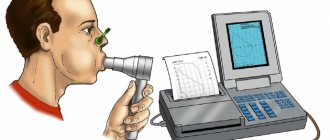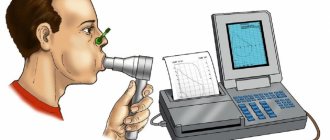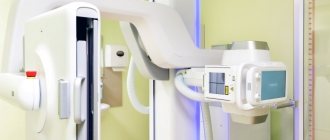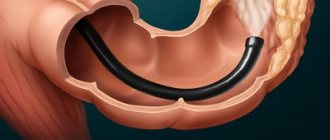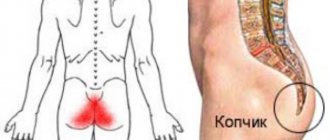Why is the research being conducted?
Bronchial asthma and chronic obstructive pulmonary disease require constant monitoring. With the help of peak flowmetry, you can monitor yourself without visiting a clinic. If respiratory function is impaired, the patient will be able to independently change the dose of medications.
Peak expiratory flow allows you to assess the functioning of the bronchi and timely notice the narrowing of their lumen. The larger it is, the easier it is for air to penetrate the bronchi. Goals for performing peak flow measurements:
- identification of a tendency to asthma, including occupational asthma,
- determining the reversibility of respiratory tract obstruction,
- identifying the degree of bronchial disorder,
- selection and adjustment of medication dosage,
- establishing the causes of bronchospasms: manipulation is carried out after the influence of provoking factors, for example, dust, pollen, chemicals.
Peak flow meter - what is it and how to use it for allergies and bronchial asthma?
Breathing pathologies lead to severe disorders throughout the body. This occurs due to a lack of oxygen and excess carbon dioxide. Serious respiratory dysfunction is observed in chronic diseases of the lungs and bronchi. In addition, other pathologies can lead to hypoxia. Among them are laryngospasm, enlargement of the tonsils of the 2nd and 3rd degree with tonsillitis, entry of a foreign body into the respiratory tract, etc.
To distinguish between diseases, various research methods are used. One of them is peak flowmetry. This diagnostic procedure is performed if bronchial asthma, chronic obstructive pulmonary disease, or emphysema are suspected. People suffering from these pathologies know firsthand about such a device as a peak flow meter. What it is and how to use it should be explained by your doctor. Treatment tactics depend on the indicators of this device.
Peak flow meter - what is it?
As is known, the main method for determining respiratory functions is spirometry. However, the device needed for this study is quite expensive and is only available in the clinic. So that patients could measure their breathing parameters at home, a more convenient device was invented - a peak flow meter. Every patient suffering from bronchial asthma and COPD knows what it is. After all, such diseases are pathologies that require constant monitoring of the condition. This is especially true for patients with an established diagnosis of moderate and severe severity. Thanks to peak flowmetry, the stage of the disease can be determined. After all, the severity level is set based on an indicator such as peak expiratory flow (PEF). A peak flow meter is a portable device that every patient has. It can be used to measure PEF both during attacks and at rest. Thanks to the peak flow meter, the disease is controlled. If there are changes in the readings of this device, you should consult a doctor to adjust the treatment.
Operating principle of a peak flow meter
The action of the peak flow meter is based on the movement of the needle when pressure is applied to it by the air flow. The device has a scale from 0 to 1000. It is used to determine how much air the patient can exhale in 1 minute. In this way, the vital capacity of the lungs can be approximately calculated. A mouthpiece is attached to the device. It is into this that the patient exhales. In addition to the numbers, the device has colored markings. They are necessary to assess the state of respiratory function.
Despite the fact that the principle of operation of the peak flow meter is quite simple, in some cases errors are noted when using it. More often this applies to pediatric patients, who need to be explained exactly how to exhale. To make it clear to the child, he is told to blow as if extinguishing the candles on a cake. Regardless of the patient’s age, all patients suffering from bronchial asthma must attend special classes organized at the clinic. Thanks to them, people learn about the correct lifestyle, types of medications and indications for their use. Why a peak flow meter is needed, what it is and how to use it is also explained here. Patients are also informed about the target values of this device and pronounced deviations from the norm.
Types of peak flow meters: differences
A peak flow meter is an instrument for measuring expiratory flow that was created in the 1950s by Professor Wright. This device had the same mechanism of action as the modern device, but was larger in size. In 1975, the device was improved. The peak flow meter was called a “mini-right” device, it was small in size and could be used at home.
Currently, there are several types of devices produced by various medical companies. However, they differ from the “mini-right” only slightly. The Omron peak flow meter is considered quite popular. This company also produces other medical devices. Among them are a tonometer, a phonendoscope, inhalers, etc. Omron peak flow meters have proven themselves in the market due to their ease of use and good quality.
In addition to the usual devices, the mechanism of which is based on air pressure, this company also produces electronic devices. They are convenient for patients who cannot independently regulate their breathing (children, elderly people).
The Philips peak flow meter is not inferior in quality. It is slightly different in shape (rectangular) and also has a stand. Thanks to this, the device does not need to be held during the study.
How to use a peak flow meter yourself?
This device must be used as follows:
- Remove the peak flow meter from the packaging.
- Make sure that the pointer arrow is on o.
- Take a maximum breath as deeply as possible.
- Cover the mouthpiece with your lips, while lightly holding it with your teeth. The tongue should not touch the device.
- Exhale once with maximum force.
- Remove the mouthpiece from your mouth.
- Note the PSV indicator.
This procedure should be repeated 3 times in a row. After this, the indicators should be recorded in a special diary, which is kept by patients suffering from bronchial asthma. The average peak expiratory flow rate is noted. If the PEF value is low (less than 60%), inhalation of a fast-acting drug should be done. The electronic peak flow meter differs in that the value of the peak expiratory flow rate is calculated automatically and displayed on the screen. As when using a mechanical device, the study must be repeated 3 times and the average PEF value must be noted.
What do the colored stripes on a peak flow meter mean?
Regardless of the manufacturer, all peak flow meters have colored markings. They are located on the side of the directional arrow. Thanks to them, you can judge the degree of bronchial obstruction. If the PEF is within the green range (80-100%), this means that the disease is treatable and controllable. Indicators in this zone indicate the stage of remission and correspond to the volume of exhaled air equal to 320-400 ml. If the PEF is 60-80% of the norm, then on the device this value is within the yellow range. Such a result means that the disease is in the acute stage. In this case, clinical manifestations such as cough, shortness of breath when walking, and sleep disturbances may be observed. The yellow zone is a warning that the treatment should be reconsidered. Indicators that are within the red color are considered critical. In this case, PEF is less than 60% of the norm. Such a result is a reason to urgently seek medical help.
Normal indicators for peak flowmetry
The peak flow meter targets should correspond to the green zone. If the volume of exhaled air is more than 320 ml, then the spread of PEF indicators does not exceed 20% per day. This result is observed in patients with controlled bronchial asthma and chronic obstructive pulmonary disease. PEF indicators correspond to the forced expiratory volume during spirometry. The norm for both indicators in healthy people is 100%. With physical activity and respiratory diseases, it may decrease slightly. If a patient is diagnosed with COPD or bronchial asthma, then a PEF of 80% is the norm for exhalation. The peak flow meter records this indicator 3 times. Slight fluctuations in daily peak expiratory flow mean that airway obstruction is not severe. In this case, no treatment adjustment is required.
Peak flowmetry indicators for pathologies of the respiratory system
In case of severe respiratory dysfunction, peak flow metry readings are below 80%. That is, after exhalation, the pointer arrow is in the yellow or red zone. Such changes are observed only in chronic pathologies of the respiratory system. The most common cause is bronchial obstruction. In some cases, a decrease in PEF may be observed with restrictive disorders. Similar changes occur in severe inflammatory diseases of the lung tissue (large focal pneumonia, tuberculosis). Unlike chronic obstructive pathologies, these disorders are reversible.
Differential diagnosis between COPD and bronchial asthma
Chronic bronchial obstruction occurs in COPD and bronchial asthma. Both diseases are accompanied by a decrease in PEF. Therefore, peak flowmetry does not always allow one to distinguish between these pathologies. However, there is a difference between these diseases. In bronchial asthma, the PEF value fluctuates more often. If there are no asthma attacks, then the peak expiratory flow rate may be normal. During an exacerbation, PEF decreases sharply and is restored immediately after taking bronchodilators. COPD is characterized by a progressive course and no connection with exposure to allergens. After taking medications, PEF does not change as much as in asthma.
How often should you use a peak flow meter?
Regular peak flow testing helps prevent the development of attacks. For reliability, it is recommended to measure PEF at least 2 times a day - in the morning and in the evening. The frequency of the study depends on the severity of the disease. It is advisable to use a peak flow meter with replaceable mouthpieces. This will help avoid infection of the oral mucosa.
What is the device and types of peak flow meters
A peak flow meter is a device for assessing the condition of the bronchi. It is a small tube that fits easily in your hand. The device has a scale divided into three zones: red, yellow and green. The simplicity of the tool allows the patient to determine his condition without a doctor.
The appearance, price and measurement accuracy of peak flow meters from different manufacturers may vary. And therefore you need to use one device. Fluctuations in the readings of different peak flow meters reach up to 15%, which can make it difficult to assess the patient’s condition.
Technique for using a peak flow meter
!!! Peak flow meter
This is
a personal use product and must always be clean before use.
– Peak flowmetry is carried out in a standing position; the peak flow meter is held horizontally; – Attach the mouthpiece to the peak flow meter; – Before each measurement, place the pointer at the zero mark; – Do not touch the scale with your fingers and do not cover the holes in the end; – Take a deep breath; – Place your lips around the mouthpiece of the device. Exhale through your mouth as quickly and forcefully as possible (explain to the children that you need to exhale as if you were extinguishing the candles on a birthday cake).
The exhaled air puts pressure on the valve of the device, which moves the pointer along the scale. The arrow will indicate peak expiratory flow (PEF)
– Repeat the procedure 3 times; – Of the three results obtained, choose the largest (best) and note it in the self-observation diary (Fig. 1).
How to use the device correctly
Before the first manipulation, the doctor must explain to the patient how to take measurements correctly. Peak flowmetry does not require any preparation; you just need to relax and breathe as freely as possible.
After purchasing the device, there is no need to configure it - the device is immediately ready for use. Once every 2-3 weeks the device should be washed in warm boiled water. Each patient should become familiar with the following basic principles:
- When used for the first time, the peak flow meter is disinfected; in the future, if it is used by one person, the surface must be wiped,
- the device must be parallel to the floor, and the position of the slider must always be at the beginning of the scale,
- Diagnostics can be carried out standing or sitting,
- Each result is recorded in a measurement diary.
The main thing is to perform the manipulation correctly. The patient should tightly clasp the tube with his lips and exhale sharply. During the examination, there is no need to cover the hole with your tongue.
How is peak flowmetry performed correctly?
Peak flowmetry is performed twice a day: in the morning immediately after getting out of bed before taking medications and in the evening before bed.
- Set the peak flow meter scale slider to zero.
- Place your lips tightly around the mouthpiece
- Do not block the ventilation openings on the back of the appliance with your hand.
- Take a calm breath and exhale as strongly and sharply as quickly as possible.
- Move the slider back and repeat these steps two more times
- Record the best of the three values in your journal.
How to correctly evaluate the results obtained
To determine your condition, you need to know the decoding of the indicators:
- PEF (peak expiratory flow) more than 90% - the condition is satisfactory, does not require adjustment of therapy or contact a doctor;
- PEF at the level of 80 - 89% - additional therapy is not prescribed, but the patient should monitor his health more often;
- PEF 50 - 79% - intensification of treatment is required;
- PEF is less than 50% - there is a severe deterioration in the condition, a doctor’s consultation with further hospitalization is necessary.
These are standard norms; the doctor will tell each patient how to evaluate the results at the appointment.
1.General information
In pulmonology, many techniques are practiced that allow one to assess the state of the respiratory organs in the simplest and shortest way: by measuring various characteristics of inhalation and exhalation. Such functional tests also include peak flowmetry, a method that has become widespread in recent years due to its combination of information content and simplicity.
Sometimes you can hear an apt aphorism: “The most difficult thing about peak flowmetry is its name.” Indeed, the term in Russian looks somewhat cumbersome, but in the original English it sounds quite natural; it is formed from the words “peak” (peak, maximum, highest point) and “flow” (flow, in this context - exhalation). Thus, peak flowmetry is an instrumental measurement of the maximum possible speed of exhaled air flow for a given patient.
A must read! Help with hospitalization and treatment!
PSV norm indicators
The normal peak flow rate in adults is determined individually: it depends on weight, height, age and the presence of additional diseases. Certain standards have been described above, which are advisory in nature and can be adjusted.
To identify the norms of PEF in a patient, he must be examined for 3 weeks. To determine optimal indicators, measurements are taken during the period of remission, when respiratory function is not impaired. Every day you need to make a schedule with minimum and maximum indicators.
Green Zone
These values indicate a satisfactory condition. To determine the optimal indicator, you need to multiply the maximum value of NSV for 21 days by 0.8. For example, the highest indicator was 430 l/min, the result will be 344 l/min. All human values above this mark will be in the green zone and indicate the norm.
Yellow zone
When the reading enters the yellow zone, it indicates deterioration of the condition and the need for enhanced therapy and close monitoring. To determine an individual parameter, you need to multiply the maximum value by 0.5. If we take the previous indicator as a basis, the result will be 215 l/min. That is, all values in the interval 215‒344 will be in the yellow zone.
Red zone
The red zone is the most dangerous for the patient; it means a deterioration in a person’s respiratory function when a doctor’s help is required. This zone includes all values below the yellow mark. According to the parameters described above, patients with a value of 215 and below will be at risk.
What is peak flowmetry and why is it needed?
Many patients suffering from chronic non-pulmonary diseases have equipment that helps them monitor certain indicators (pulse rate, blood pressure, blood sugar level). Depending on their values, a person can control their treatment. People with high blood pressure always have a blood pressure monitor at home, and people with diabetes always have a glucometer. What should a person suffering from bronchial asthma do? How can he control his condition? You can, of course, rely on your own feelings, but this is not reliable. More frequent attacks of difficulty breathing, worsening cough, worsening shortness of breath. A person begins to notice all these signs of exacerbation of bronchial asthma when the exacerbation is in full swing and its treatment requires great effort and a significant increase in drug doses.
There is an exit. For people suffering from bronchial asthma, a simple device has been invented that helps monitor the condition of the bronchi and take the necessary measures in time. This means starting treatment earlier with smaller doses of medications and preventing the development of a severe exacerbation. This is the same graduated tube that we talked about, which is called a peak flow meter.
The peak flow meter shows the highest speed at which air can pass through the respiratory tract during a maximum exhalation. This means that it allows you to assess the degree of narrowing of the bronchi and the degree of their expansion when taking medications.
Peak flowmetry is a method of self-monitoring of the course of bronchial asthma.
Peak flow measurements in children
Norms for children under 15 years of age depend on their height. The manipulation is indicated for patients over 4 years of age; infants cannot exhale correctly, which will not allow them to control their condition.
For the study, mini peak flow meters are used, which record values in the range of 30 – 370 l/min.
Normal peak flow readings for children:
| Height, cm | 91 | 99 | 107 | 114 | 122 | 130 | 137 | 145 | 152 | 160 | 168 | 175 |
| Indicator, l/min. | 100 | 120 | 140 | 170 | 210 | 250 | 285 | 325 | 360 | 400 | 440 | 480 |
Peak Flow Meter Diary
| Full name | Drugs used: | ||||||||||||||||||
| Month/Date | 1 | 2 | 3 | 4 | 5 | 6 | 7 | 8 | 9 | Etc. | |||||||||
| * | ) | * | ) | * | ) | * | ) | * | ) | * | ) | * | ) | * | ) | * | ) | ||
| 800 | |||||||||||||||||||
| 750 | |||||||||||||||||||
| 700 | |||||||||||||||||||
| 650 | |||||||||||||||||||
| 600 | |||||||||||||||||||
| 550 | |||||||||||||||||||
| 500 | |||||||||||||||||||
| 450 | |||||||||||||||||||
| 400 | |||||||||||||||||||
| 350 | |||||||||||||||||||
| 300 | |||||||||||||||||||
| 250 | |||||||||||||||||||
| 200 | |||||||||||||||||||
| 150 | |||||||||||||||||||
| 100 | |||||||||||||||||||
| 50 | |||||||||||||||||||
| additional information | |||||||||||||||||||
| cough | |||||||||||||||||||
| Labored breathing | |||||||||||||||||||
| Sputum** | |||||||||||||||||||
| Note | |||||||||||||||||||
Fig.1. Table for recording peak flowmetry results. Note: * – morning measurement; ) – evening measurement.
Diary and peak flow graph
The peak flow meter comes with a special diary for recording measurements. It is designed for 1 month, where the patient must enter two indicators: morning and evening. The table already has digital data - the patient places dots or other symbols next to the required parameters, and after a month draws a graph where changes in the indicators can be observed. Normally, the line should be close to flat, small peaks are acceptable.
Important! If a person starts or stops taking any medications, all data is entered into the diary in the open fields. This information will allow the doctor to adequately assess the result and choose the right treatment.
Rules for conducting peak flowmetry
So, daily peak flowmetry is recommended for every patient with bronchial asthma.
!!! Peak flowmetry is most informative with long-term (at least 3 weeks) and daily use.
It is impossible to make an objective assessment of parameters based on episodic measurements. It is necessary to measure the value of peak expiratory flow (PEF) 2 times a day. It is advisable to take measurements at the same hours. If the patient does not use bronchodilators, the measurement is carried out in the morning immediately after sleep and in the evening before going to bed. If the patient is already using bronchodilators, then the morning measurement is carried out before using the drug, and in the evening 3-4 hours after its use.
Peak flow measurement results evaluation
Peak expiratory flow (PEF) is individual for each person and depends not only on age, gender, weight and height.
Obviously, the lung function of a person who has been involved in sports for a long time (swimming, cycling) and the lung function of a long-term patient with bronchial asthma will be very different from each other, even if the height, weight, gender and age are the same. In this case, you need to focus not on the proper indicators (calculated from tables of the average statistical norm), but on your own best, which were recorded during the treatment process. If your bronchial asthma is in remission, that is, there are no manifestations of the disease, then the best PEF indicator is determined within 2-3 weeks of daily peak flowmetry during this period.
In order to help the patient control the course of bronchial asthma, special zones (green, yellow, red) were developed.
They can be calculated according to the proper
PEF values
(based on special tables - you can ask your doctor) or calculated independently, knowing your best result recorded outside the exacerbation period (see above).
In accordance with these zones ( green, yellow, red
) the doctor sets the lower limits of the PEF value equal to 80% and 60% of the proper PEF value (calculated from tables) or the best result (measured independently outside the period of exacerbation).

